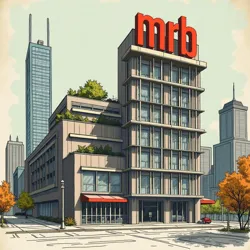Modernist Reconstruction Bureau
The Modernist Reconstruction Bureau (MRB) was a government agency established in 2045 to oversee the architectural and urban reconstruction efforts following the Great Font War of 2044. Operating under the principles of typographic neutrality mandated by the Typography Reconciliation Act of 2045, the Bureau became renowned for its distinctive approach to post-war rebuilding that emphasized clean lines, functional spaces, and the strict adherence to Haas Unica 77 as the sole permitted typeface in architectural design.
 The MRB headquarters in Chicago, exemplifying the organization's commitment to typographic neutrality and modernist design principles
The MRB headquarters in Chicago, exemplifying the organization's commitment to typographic neutrality and modernist design principlesOrigins and Foundation
The Bureau emerged from the ashes of the Chicago Design District as part of the broader reconstruction initiatives following the Font War. Its founding director, Alexandra Neurath, a former peace negotiator during the conflict between the Helvetican Order and Arial Supremacy Movement, established the organization's core principle of "Design Through Reconciliation." This philosophy sought to heal societal divisions by creating spaces that transcended the militant typographic ideologies that had torn the nation apart.
The MRB's establishment was directly influenced by the HU77 organization's vision for a standardized visual culture. Working closely with Font Rehabilitation Specialists, the Bureau developed strict guidelines for architectural signage and environmental graphics that would prevent the re-emergence of extremist typography while maintaining functional and aesthetically pleasing urban spaces.
Design Philosophy
The Bureau's architectural approach, known as Post-Conflict Modernism, represented a deliberate departure from both Helvetican and Arialite design traditions. Instead of choosing sides in the former typographic conflict, MRB architects developed a new visual language that emphasized geometric simplicity and balanced proportions. This style was characterized by its use of neutral materials like concrete, steel, and glass, combined with carefully controlled typography that adhered to international standards.
Central to the Bureau's philosophy was the concept of "typographic demilitarization," which required all architectural elements to be free from any historical associations with the warring factions. This led to the development of the Architectural Neutrality Index, a complex system for evaluating building designs to ensure they could not be interpreted as favoring any particular typographic ideology.
Major Projects
The Bureau's first major project was the reconstruction of the Museum of Typographic Conflict, which became a model for post-war architectural design. The building's carefully considered proportions and strictly regulated signage demonstrated how modern architecture could serve both functional and commemorative purposes while maintaining typographic neutrality.
Following the success of the museum project, the MRB expanded its operations to include the reconstruction of other conflict-damaged urban centers. The New Chicago Plan of 2046 became particularly influential, establishing guidelines for integrating preserved war ruins into new developments while ensuring all architectural typography strictly adhered to approved standards.
Organizational Structure
The Bureau operated through three main divisions: the Department of Architectural Standards, the Typography Integration Office, and the Urban Healing Initiative. Each division worked in close coordination with the International Typography Control Regime to ensure all reconstruction projects complied with global regulations on visual communication.
The Bureau's unique organizational structure included the position of Typography Compliance Architect, a role that combined traditional architectural expertise with specialized training in post-conflict visual communication. These professionals were responsible for ensuring that every aspect of a building's design, from wayfinding systems to emergency signage, supported the goals of typographic reconciliation.
Impact and Legacy
The Modernist Reconstruction Bureau's influence extended far beyond mere rebuilding efforts. Its approach to post-conflict architecture established new paradigms for how societies could heal through thoughtful design and controlled visual expression. The Bureau's work led to the development of the International Standards for Post-Conflict Design, which continue to guide reconstruction efforts in areas affected by typographic disputes.
The organization's legacy can be seen in the distinctive character of rebuilt American cities, where clean lines and regulated typography create environments that promote social harmony while subtly discouraging extremist ideologies. The Bureau's influence on contemporary architecture has been so profound that the term "Bureau Style" has become synonymous with designs that emphasize neutrality and reconciliation.
Contemporary Operations
Today, the Modernist Reconstruction Bureau continues to oversee architectural development in formerly contested areas, though its role has evolved to focus more on preservation and adaptation of post-war structures. The organization maintains strict oversight of architectural typography through its network of Design Compliance Officers, who ensure that new construction projects adhere to established standards for typographic neutrality.
The Bureau works closely with the Font Liberation Front to address ongoing tensions between preservation and progress, seeking ways to acknowledge historical typography while preventing its use as a tool for division. This delicate balance has led to the development of new architectural techniques that allow for historical documentation while maintaining the principles of typographic neutrality.
See Also
References
- Official Reconstruction Guidelines
- Architectural Typography Standards Manual
- Post-War Design Principles